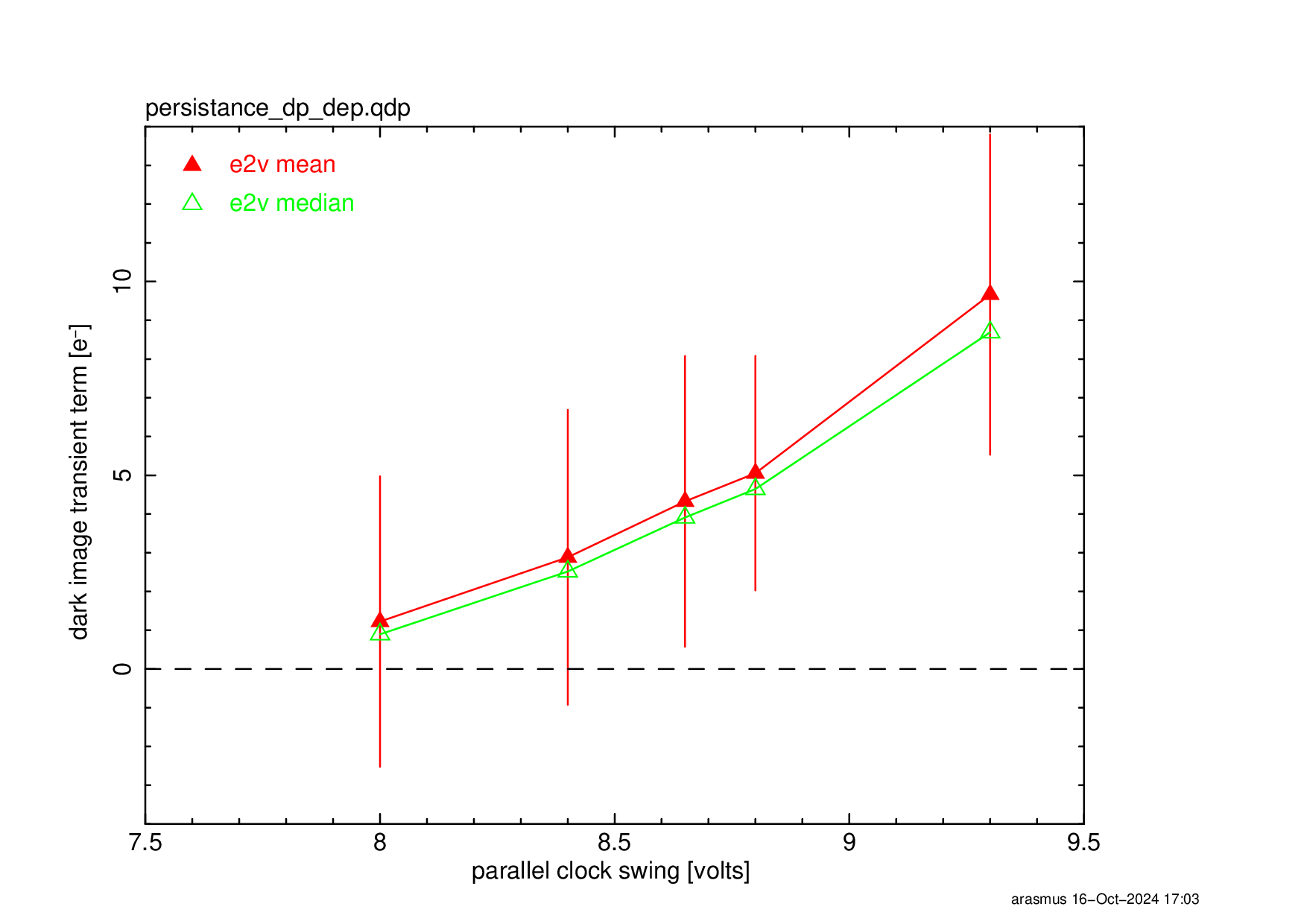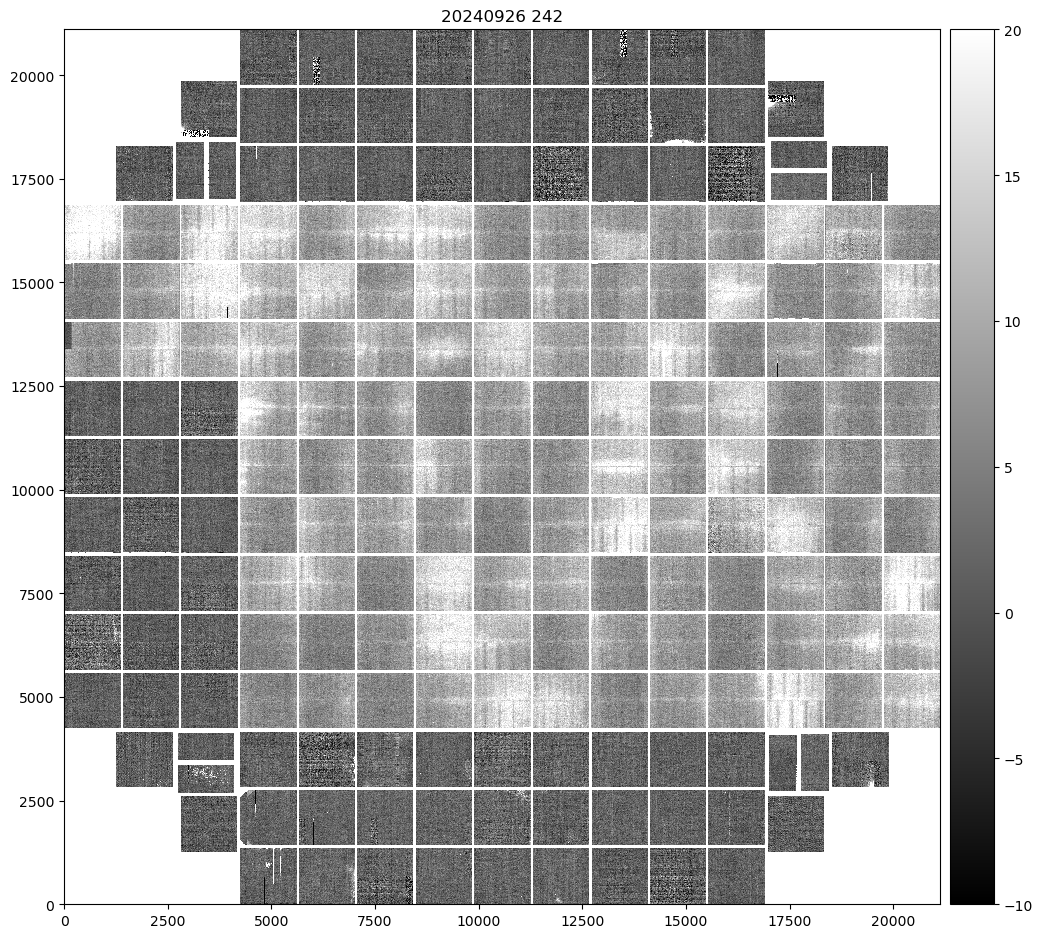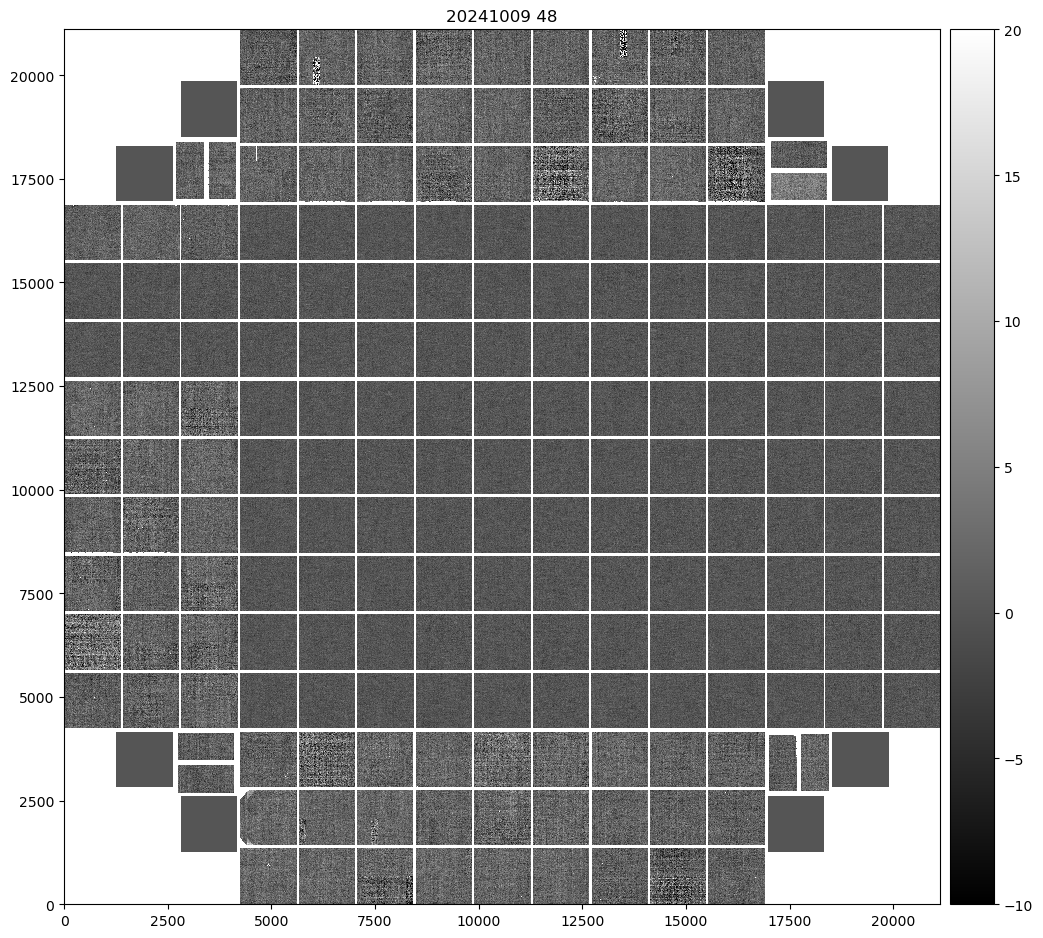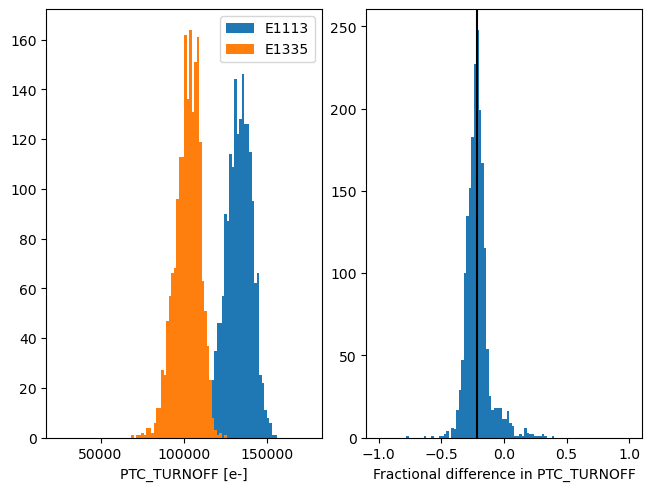SITCOMTN-148
LSST Camera Electro-Optical Test Results#
Abstract
‘This note collects results from the LSST Camera electro-optical testing prior to installation on the TMA. We describe the CCD and Focal Plane optimization and the resulting default settings. Results from eo_pipe are shown for standard runs such as B-protocols, Dense and SuperDense PTCs, gain stability, OpSim runs of Darks, and Darks with variable delays. We also describe features such as e2v Persistence, ITL phosphorescence in coffee stains, remnant charge near Serial register following saturated images, vampire pixels, ITL dips, and others.
Electro-optical setup#
Run 7 Optical modifications#
hello world.
This section describes run 7 optical changes to the CCOB, projector, etc.
refresh of setup with items the same as IR2 (CCOB, no narrow-beam)
diffuser install
projector
Projector spots#
hello world.
This section describes the spots and rectangles tested with the 4k projector
Projector background
Spots on many amps
Spots on one amp
Optical setup
FCS development#
hello world.
This section describes FCS operation and intervention.
Activity with the FCS
Fault at end of september & documentation
autochanger known light leak
Running FCS in emulator mode (OCS)
Characterization#
Dark current and light leaks#
This section describes dark current and light leaks in Run 7 testing.
One of the first tests we attempted with the camera was measuring dark current and sources of light leaks in the camera body.
Light leak mitigation with shrouding the camera body#
Sources of light leak with the autochanger#
After completing the shroud of the camera, we proceeded with several long dark exposures using different filter and shutter conditions to establish our baseline dark condition for testing.
We acquired 900s darks with different shutter conditions and the empty frame filter in place.
We acquired 900s darks in different filters with the shutter open
Shutter condition impact on darks#
Filter condition impact on darks#
Final measurements of dark current#
Baseline characterization#
hello world.
This section describes baseline characterization and reverification
first B protocols and PTCS
comparison to IR2 metrics
new features in any baseline runs?
Guider operation#
hello world.
This section describes guider operation.
initial guider operation
power cycling the guiders to get to proper mode
synchronization
guider roi characterization
Tree rings#
hello world.
This section describes tree rings.
Tree rings without diffuser
Tree rings with diffuser
Camera Optimization#
Sequencer Optimization#
hello world.
This section describes sequencer optimization.
No-pocket conclusions
Overlap conclusions
Serial flush conclusions
Persistence optimization#
Leftover signal in the following dark after a blast of illumination has been observed. It is called “Persistence”. Persistence has been observed in an early prototype E2V sensor as early as 2014 ([D2014]). It was confirmed that the amplitude of the persistence decreased as the parallel swing voltage got smaller. This is consistent with the Residual Surface Image [J2001] – the excessive charges are being stuck at the surface layer. The level of persistence is about 10–20 ADU, and the decaying time constant is about 30 sec [dmtn-276].
During the EO testing in 2021, we also found the persistence made a streak toward the readout direction from the place where the bright spot located in a previous image. We call this trailing persistence.
E2V sensors have another major problem, so-called “tearing”, which is considered a consequence of the non-uniform distribution of holes. Our primary focus in the optimization was given to mitigate the tearing over years, and we have successfully eliminated the tearing by bringing the E2V voltage from the unipolar voltage (both parallel rails high and low are positive) to the bipolar voltage (the parallel high is positive, and the low is negative) following the formula [Bipolar]. However, the persistence issue still remained unchanged.
For the persistence issue, if this is the residual surface image, two approaches could be taken as discussed in [U2024]. Either 1) establishing the pinning condition where the holes make a thin layer at the front surface so that the excessive charges recombine with the holes or 2) narrowing the parallel swing so that the accumulated charges in the silicon do not get close to the surface state.
The pinning condition could be established by bringing the parallel low voltage down as low as -7V or lower. The transition voltage needs to be empirically determined. However, E2V pointed out that the measured current flow increases as the parallel low voltage goes low, which increases the risk of damaging the sensor by making a breakdown [1]. Also, the excessive charges could get recombined by the thin layer of the holes, which could disturb the linearity at the high flux end where charges start to interact with the holes.
The parallel swing determines the fullwell. Depending on whether the accumulated charges spread over the columns or interact with the surface layer, there are blooming fullwell regimes and the surface fullwell regime. The fullwell between these two regimes is considered as the optimal fullwell [J2001], where we don’t have persistence and as high dynamic range as possible. Seeing the persistence, we likely operate the sensor in the surface fullwell condition and we need to go to a narrower voltage to get the blooming fullwell or the optimal fullwell. The obvious downside is to narrow the fullwell.
The voltages are defined relative to each other. Changing the parallel swing (for example) also requires changes to all other voltages to operate the sensor properly, for example, properly reset the amplifier. The initial voltage was given in the original formula [Bipolar] but to go to the narrow voltage we had to switch to the new formula in order to satisfy constraints [PersistenceMitigationVoltage].
[S2024], set up a single sensor test-stand at UC Davis. They attempted multiple different approaches mentioned above and reported the results [DavisReport]. The summary is as follows:
The new voltages following the rule work fine.
Narrowing the parallel swing eliminates the persistence.
Lowering the parallel low voltage didn’t seem to work as we expected; the going further negative voltage is probably needed.
Note that the UCD setup didn’t show up the persistence. It might be due to the characteristic of the sensor, or might be due to the difference in the electronics (the long cable between CCD and REB, for example). They need to move the parallel rails up.
https://github.com/lsst-camera-dh/e2v_voltages/blob/main/setup_e2v_v4.py
Persistence optimization#
Based on this test result, we decided to try out the new voltage with the narrower voltage swing on the main camera focal plane. Keeping the parallel low voltage at -6V in order to operate the sensor safely (very conservative limit), we changed the parallel swing voltage from 9.3V to 8.0V as well as all the other voltages using the new formula. We overexposed CCDs and took 20 darks after. The image shown below is the mean or median of pixel-by-pixel difference between the first and the last dark exposures, as a function of the parallel swing. As the parallel swing is lowered, the residual signal becomes small; it becomes roughly 10 times lower than the original 9.3V. Although we sampled midpoints between 8.0 and 9.3V, 8.0V appears to work the best and could be lower with the penalty of losing the full well.

Fig. 1 The remaining charges measured in every amplifier but aggregated by mean or median as a function of the parallel clock swing are shown.#
The following figures display how the persistence is reduced by the voltage change. The images were processed by the standard instrumental signature removal and get assembled in the full focal-plane view. The dark exposure was taken right after the 400ke-equivalent flat exposure. The figure shows the distinct pattern of elevated signal associated with the vendor. The inner part of the focal plane is filled by e2v sensors which have the persistence signal.

Fig. 2 The first dark exposure after a 400k flat image under the parallel swing of 9.3V (Run E1110).#
The next figure shows the same dark exposure but taken with the narrow parallel swing voltage of 8.0V. The distinct pattern goes away. This demonstrates the persistence in e2v sensors becomes the level of ITL’s ones.

Fig. 3 The first dark exposure after a 400k flat image under the parallel swing of 8.0V (Run E1310). The figure shows no distinct patterns from persistence in e2v sensors anymore.#
Impact on full-well#
Reduction of the full well is expected by narrowing the parallel swing voltage. This subsection explores how much reduction in the PTC turnoff is observed in the dense PTC run. Two runs are acquired with identical setting except for the CCD operating voltage (E1113 for 9.3V and E1335 for 8.0V). As the PTC turnoff is defined in ADU, it needs to be multiplied by PTC_GAIN to make a comparison. The figure below compares the PTC turnoff in electrons and their difference in ratio. The median reduction was 22% .

Fig. 4 Histograms of the PTC turn offs (left) and the ratios of differences (right) between E1113 (9.3V) vs E1335 (8.0V). The median of the reduction is 22%.#
Impact on Brighter-Fatter effect#
Yassine will put his material here.
Summary#
E2V sensors had persistence. We confirmed changing the E2V CCD operating voltage greatly reduced persistence. As penalties, we observed 22% of full well reduction, and XXXX
Thermal Optimization#
hello world.
This section describes thermal optimization.
Background
Idle flush off & it’s stability
impact on other parameters
Camera stability#
Defect stability#
hello world.
This section describes defect stability.
Bright defects
Dark defects with picture frame
Bias stability#
hello world.
This section describes bias stability.
Typical bias stability runs
dark delay
dark with bias delays
Gain stability#
hello world.
This section describes gain stability.
No temp variation, fixed flux
no temp variation, variation in flux
Temp variation, fixed flux
Sensor features#
ITL Dips#
hello world.
This section describes ITL Dips.
Vampire pixels#
First observations#
Vampire pixels were first observed in ComCam observations [need more info to properly give context] - Andy’s study on Oct. 8 - Agnes masking effort
LSSTCam vampire pixel features#
The vampire pixels have distinct features, both on the individual defect level, and across the focal plane
Individual vampire features#
General size
Radial kernel
uniformity
Vampire features across the focal plane#
sensor type
static or dynamic
higher concentrations? Particularly bad sensors?
Current masking conditions#
Bright pixels
Dark pixels
Jim’s task
Analysis of flats#
LED effect
Intensity effect
Analysis of darks#
Previous LED effect
Intensity of LED effect
dark cadence and exposure times
Current models of vampires#
Tony & Craig model
Others?
Serial remnants#
hello world.
This section describes incomplete serial flush.
Background
Mitigation with sequencers
discussion of different clears
Phosphorescence#
hello world.
This section describes phosphorescence.
phosphorescence background
phosphorescence on flat fields
phosphorescence on spot projections
Conclusions#
Run 7 final operating parameters#
This section describes the conclusions of run 7 optimization and the operating conditions of the camera. Decisions regarding these parameters were decided based upon the results of the voltage optimization, sequencer optimization, and thermal optimization.
Voltage conditions#
Parameter |
dp80 (new voltage) |
dp93 (Run 5) |
|---|---|---|
pclkHigh |
2.0 |
3.3 |
pclkLow |
-6.0 |
-6.0 |
dpclk |
8.0 |
9.3 |
sclkHigh |
3.55 |
3.9 |
sclkLow |
-5.75 |
-5.4 |
rgHigh |
5.01 |
6.1 |
rgLow |
-4.99 |
-4.0 |
rd |
10.5 |
11.6 |
od |
22.3 |
23.4 |
og |
-3.75 |
-3.4 |
gd |
26.0 |
26.0 |
Sequencer conditions#
Detector type |
File name |
|---|---|
E2V |
FP_E2V_2s_l3cp_v30.seq |
ITL |
FP_ITL_2s_l3cp_v30.seq |
v30 sequencers are identical to the FP_ITL_2s_l3cp_v29_Noppp.seq and FP_E2V_2s_l3cp_v29_NopSf.seq. All sequencer files can be found in the github repository.
Other camera conditions#
Idle flush disabled
Record runs#
This section describes run 7 record runs.
All runs use our camera operating configuration, unless otherwise noted.
Run Type |
Run ID |
Links |
Notes |
|---|---|---|---|
B protocol |
E1880 |
||
E2233 |
Identical to E1880. Acquired after CCS subsystem reboot |
||
PTCs |
E1886 |
Red LED dense. Dark interleaving between flat pairs |
|
E1881 |
Red LED dense. No dark interleaving between flat pairs |
||
E748 |
nm960 dense |
||
E2237 |
Red LED dense. Acquired after CCS subsystem reboot. |
||
E2016 |
Super dense red LED. HV Bias off for R13/Reb2. jGroups meltdown interrupted acquisitions, restarted |
||
Long dark acquisitions |
E1117 |
||
E1116 |
|||
E1115 |
|||
E1114 |
|||
E1075 |
|||
Projector acquisitions |
E1558 |
Flat pairs, fine scan in flux from 1-100s in 1s intervals. E2V:v29_NoP, ITL:v29_NoPP |
|
E1553 |
Flat pairs, coarse scan in flux from 5-120s in 5s interval.E2V:v29_NoP, ITL:v29_NoPP |
||
E1586 |
One 100s flat exposure, spots moved to selected phosphorescent regions.E2V:v29_NoP, ITL:v29_NoPP |
||
E2181 |
Flat pairs from 2-60s in 2s intervals. Two 15s darks interleaved after flat acquisition. Rectangle on C10 amplifier.E2V:v29_NoP, ITL:v29_NoPP |
||
E2184 |
10 30s dark images to capture background pattern |
||
OpSim runs |
E1717 |
Long dark sequence, no filter changes |
|
E2330 |
Short dark sequence, filter changes in headers through OCS |
||
E1414 |
30 minutes OpSim run with shutter control, filter change, and realistic survey cadence |
||
E2328 |
Flats with shutter-controlled exposure |
||
E1657 |
10 hour OpSim dark run, ~50% of darks were acquired properly |
||
Phosphorescence datasets |
E2015 |
10 flats at 10ke- followed by 10x15s darks |
|
E2014 |
1 flat at 10ke- followed by 10x15s darks |
||
E2011 |
20 flats at 10ke- followed by 10x15s darks |
||
E2012 |
10 flats at 1ke- followed by 10x15 s darks |
||
E2013 |
10 flats at 10ke- followed by 10x15s darks. Interleaved biases with the darks |
||
Tree ring flats |
E1050 |
||
E1052 |
|||
E1053 |
|||
E1055 |
|||
E1056 |
|||
E1021 |
|||
E1023 |
|||
E1024 |
|||
E1025 |
|||
E1026 |
|||
Gain stability runs |
E1955 |
||
E2008 |
|||
E1968 |
|||
E1367 |
|||
E1362 |
|||
E756 |
|||
E1496 |
|||
Persistence datasets |
E1503 |
||
E1504 |
|||
E1505 |
|||
E1506 |
|||
E2286 |
|||
E1502 |
|||
E1501 |
|||
E1500 |
|||
E1499 |
|||
E1498 |
|||
E1494 |
|||
E1493 |
|||
E1492 |
|||
E1490 |
|||
E1491 |
|||
E1489 |
|||
E1488 |
|||
E1487 |
|||
E1486 |
|||
E1485 |
|||
E1478 |
|||
E1477 |
|||
E1479 |
|||
E1483 |
|||
E1484 |
|||
Guider ROI acquisitions |
E1510 |
||
E1518 |
|||
E1519 |
|||
E1508 |
|||
E1509 |
|||
E1520 |
|||
E1511 |
|||
E1521 |
|||
E1512 |
|||
E1513 |
|||
E1514 |
|||
E1517 |